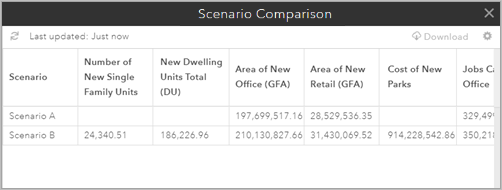ArcGIS GeoPlanner is a multiple-scenario planning and design app. GeoPlanner includes tools to help you compare scenarios so you, your team, and your stakeholders can make informed and evidence-based decisions. It has reports that help you inventory the types of natural assets in an area and catalog how the features in your plan summarize models and assessment layers.
Scenario Comparison
The Scenario Comparison table displays indicator values
for one or more scenarios. This allows you to compare indicator values
across many scenarios for a project-level view
of performance. You can also download the table as a .csv file.
The following steps detail how to create a Scenario Comparison table. Ensure you have one or more indicators before completing the following steps.
Note:
If you created a project from the Basic, Economic Development Planning or Green Infrastructure Planning templates, you already have indicators in your project.
- Create a Scenario Indicator if you don't have one.
- Click the Evaluate tab on the app toolbar.
- Click Scenario Comparison.
- In the Select Scenarios dialog box, check the scenario check boxes to include in the table.
- Click Load Table.
Note:
Baseline Indicators will contain the same value for all scenarios.
- To download the table, click Download.
- To generate a new table with different scenarios, click the Settings button
 to access the Select Scenarios dialog box.
to access the Select Scenarios dialog box.
Indicator report
GeoPlanner's Indicator Report is similar to the Scenario Comparison table in that it shows a summary of dashboard indicators from one or more scenarios. The Indicator Report only reports on the chart indicators in your project. It displays the distribution of types in a dashboard chart indicator and how each type summarizes a model or assessment layer. Types correspond to the primary chart indicator and models or assessment layers to the secondary chart indicator. You can also report on how each individual feature summarizes a model. This gives you potential suitability scores per feature. The following table illustrates the output from this report when reporting by feature type:
| Scenario | Chart | Layer | Type | Value | Units | Percent | Evaluation Layer | Weighted Score | Percent |
|---|---|---|---|---|---|---|---|---|---|
Scenario B | Design | Basislaag | Openbaargroen | 28.494 | Hectares | 27 | Proximity | 5 Medium | 43 |
Scenario B | Design | Basislaag | 6 Medium+ | 57 | |||||
Scenario B | Design | Basislaag | Privaat | 79.389 | Hectares | 73 | 5 Medium | 47 | |
Scenario B | Design | Basislaag | 3 Low+ | 53 |
Use this report to understand the impact of all types or all features against a model or assessment layer. This report helps you understand suitability scores for each type or each feature in a type.
Complete the following steps to generate an Indicator Report:
- In GeoPlanner, create a suitability model using the Modeler or the Classify tool.
- Click the Dashboard
 button on the map and configure the following:
button on the map and configure the following:- Configure the primary chart indicator to report on your scenario features.
- Configure the secondary chart indicator to report on the model you created in the previous step.
- Click the Evaluate tab.
- Click the Report drop-down arrow and choose Indicator Report.
- Click the Report drop-down arrow and check one or more of the Chart Indicator check boxes.
- Scenario and Baseline Indicator—Show information about the indicator values from your scenario in a report.
- Chart Indicator (Per Type)—Show information about the charts from your scenarios sorted by type in a report.
- Chart Indicator (Per Feature)—Show information about the charts from your scenarios sorted by feature in your report.
- Click the Scenario drop-down arrow and choose the scenarios for which you want a report.
- Click the Indicator drop-down arrow and choose the indicators that you want to use to generate a report.
- Optionally, check the check box next to Hide evaluation details to remove the score values from the report.
Note:
Checking this check box is not necessary for reports using the Scenario and Baseline Indicator option.
- Click Run.
The tool runs and generates a compressed folder containing the reports you chose. The format of each report is a .csv file. You can open these reports in a spreadsheet program such as Microsoft Excel.